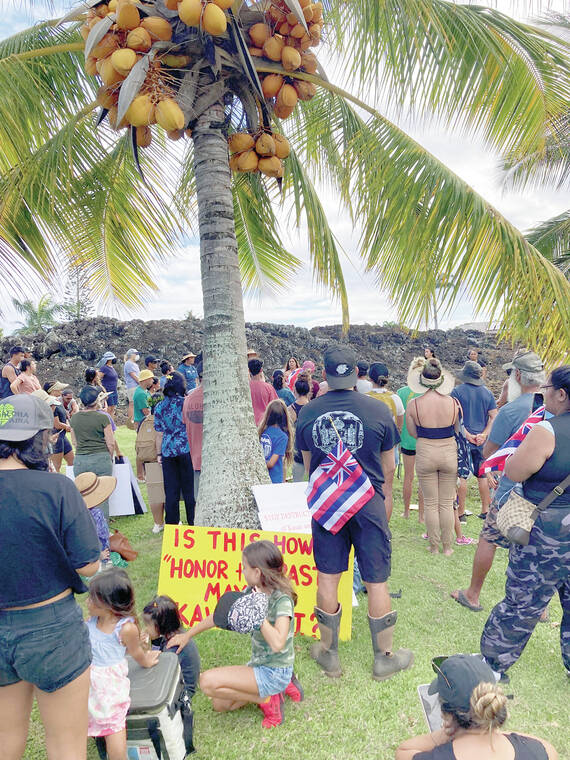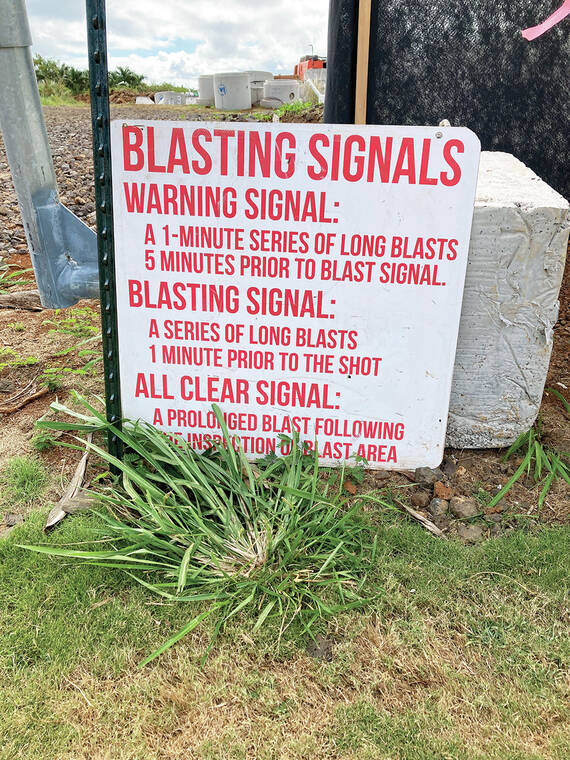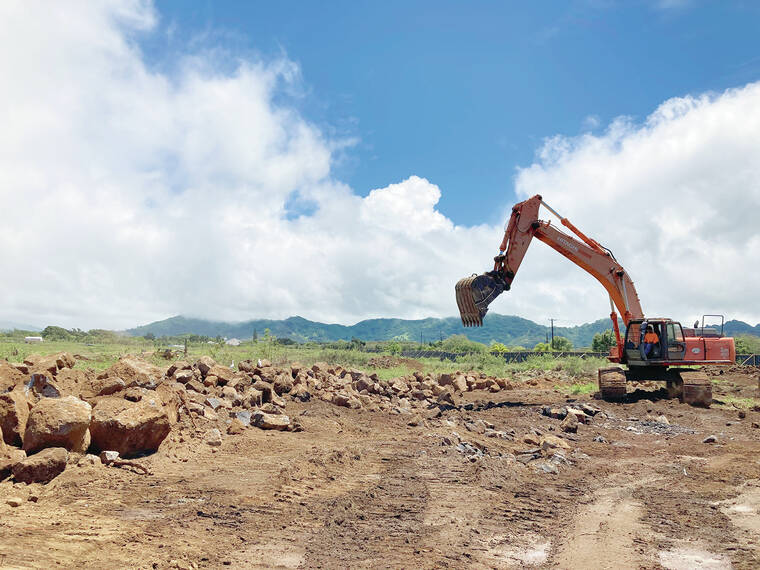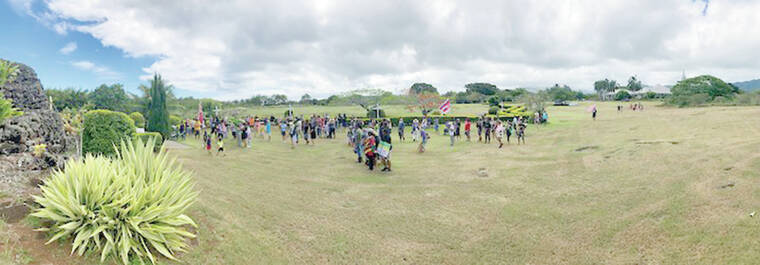PO‘IPU — More than 150 activists from throughout the state gathered last week in the latest and largest protest against a planned luxury condominium complex.
The parcel will include 279 residential units starting at $1,199,000, if built. Preparatory blasting excavation, which began May 23, ignited the nearly three-hour march around and through developer Meridian Pacific’s 25-acre parcel adjacent to the Kiahuna Golf Course.
Organizers included local nonprofits Save Koloa and Friends of Maha‘ulepu, which filed a lawsuit against Meridian Pacific and the County of Kaua‘i last month.
The groups believe developers’ blasting has exposed and destroyed caves likely home to endangered species found nowhere else on Earth.
“If there’s no caves, why are they dynamiting? We know why. They’re blowing off the tops,” Friends of Maha‘ulepu President Bridget Hammerquist said.
Populations of the federally-endangered pe‘e pe‘e maka‘ole (Kaua‘i cave wolf spider, Adelocosa anops) and ‘uku noho ana (Kaua‘i cave amphipod, Spelaeorchestia koloana), have been documented in the cave systems surrounding the 25-acre parcel. But the presence of the subterranean invertebrates, which are endemic to Koloa, has not been confirmed within the development site Meridian Pacific has named “Kauanoe o Koloa.”
Activists’ claims regarding cave exposures stem from drone footage taken after contractors’ daily blasting operations.
The videos, which are available online, show the rubble created by the daily blasts. Distinct shadows and gaps can be seen between the rocks.
But these shadows and gaps are not indicative of an underlying cave system, according to Meridian Pacific Vice President of Construction Colin Thompson and his team of specialists.
Fragmented rocks and boulders occur when blasts break apart solid rock, said Dr. Chuck Blay, a geoscientist and Kaua‘i resident retained by Meridian Pacific.
“When it collapses back down, (the fragments) don’t fit back together, so they’re really angular … you get a lot of porosity, which is artificial,” Blay continued, during a recent inspection of the property with Thompson and invertebrate biologist Dr. Steven Lee Montgomery, who is also retained by the developer.
The excavation technique, which Meridian Pacific calls “micro-blasting,” begins with a three-inch-diameter hole drilled 12 to 16 feet down into the center of the planned blast zone.
The bottom of the hole is then filled with a portion of the industrial explosive ANFO and topped off with a crushed rock product to contain the detonation.
The subsequent explosion transforms all rock surrounding the several-feet-deep hole to rubble, which is then excavated with a backhoe.
Thompson said the near-daily excavation, which may last up to eight months, is needed to install sewage and wastewater infrastructure.
Thompson, Blay and Montgomery claim any underground void potentially home to the pe‘e pe‘e maka‘ole or ‘uku noho ana should be discovered during the pre-blast drilling process.
“If the drill was going to plummet through really fast — if you’d have hard rock and then it just dropped three feet or 10 feet — you’d know you’ve got something like a lava tube down there,” said Montgomery.
“Well, that didn’t seem to happen.”
Blay and Montgomery co-authored a May 12 report stating the land does not contain any habitats of the spider or amphipod, a blind crustacean measuring up to 10 millimeters in lenth.
The scientists’ conclusion is based, in part, on a two-day exploration of the nearest lava tube, known as the Kiahuna mauka cave. Their report states the tube’s closest approach to the development is over 200 feet.
Blay claims he conducts inspections before, during and after each blast.
Montgomery assisted in scientists’ first description of pe‘e pe‘e maka‘ole and ‘uku noho ana in the early 1970s.
Both he and Blay say it’s effectively impossible to prognosticate what lies beneath the surface of the Earth in cases such as this.
However, the scientists say if there are cave habitats to be found, they will find them.
“This island is 5 million years old. It’s got these species that are so unique from anything else in the world,” Montgomery said.
“These are our famous animals, and they deserve concern. I share the concern of the ‘ohana and others who want to go extra lengths.”
Pule
Protesters assembled at St. Raphael Church in Koloa Wednesday afternoon, hours after Thompson, Blay and Montgomery concluded their tour of the blast zones.
Their concerns also include desecration of iwi kupuna (ancestral bones) and lack of affordable housing.
Some participants, like Elizabeth Lindsey of Wailua, described the march as a pule, or prayer gathering.
“There’s nowhere else in the world like our home. Why are they trying to make this like everywhere else?” Lindsey asked from the church yard.
“I’m finding, more and more, that the people of the land are connecting back to the land,” she continued. “The people who are looking to get rich from this land to make money — of all things that this world has to offer, money — just make me sick.”
Lindsey and about 160 others initiated a procession that paused at a cave located behind St. Raphael Church before heading down the historic Hapa Trail to the Meridian Pacific construction site.
Save Koloa’s founders — Elizabeth Okinaka, Nakai Villatora and Roslyn Manawaiakea Cummings — spoke throughout the march.
Villatora said her involvment is driven by spirituality.
“Our culture, our language, was all taken from us,” she explained.
“I’m able to spiritually pick up on my ancestors because I carry the same blood as them … we are as much of them as they are of us.”
Okinaka and Villatora also highlighted the lack of affordable housing on Kaua‘i.
“On top of the desecration that’s happening there, there’s a housing crisis, you know? Local families are struggling,” Okinaka said, referring to Kauanoe o Koloa units’ high price tags.
Iwi kupuna
The presence of iwi kupuna within the Kauanoe o Koloa site is also disputed.
A cultural survey prepared for Meridian Pacific found the historic 460-acre Koloa Field System in Kiahuna, which includes Kauanoe o Koloa, “was an agricultural and habitation complex notable for lack of human burials.”
The survey states no burial has been found within the Koloa Field System by archaeologists, other than a plantatation-era burial crypt on the flood plain of Waikomo Stream, west of the Meridian Pacific site.
Okinaka cites a 1978 archaeological and biological survey of the Kiahuna Golf Village area, which notes a “partially collapsed tomb containing a coffin burial.” However, she does not know the precise location of these remains.
At least one individual claims to remember ancestral burial sites in the area.
Albert Silva, 62, was born on Kaua‘i, and now resides on Hawai‘i Island.
He shared his childhood memories with The Garden Island on Thursday.
“My grandmother couldn’t drive, so my mom would pick her up at her house in Kalaheo and take her to put flowers on graves,” said Silva, who was 2 years old at the time.
His grandmother visited at least three gravesites located throughout Koloa, Silva recalled.
The first was located somewhere near the old Koloa fire station. The second, by Waikomo Stream. And the third was found beyond a St. Raphael Church boundary line, potentially on the contemporary Meridian Pacific property.
The Garden Island and Silva could not confirm this last gravesite’s location at press time due to changes in the landscape and Silva not being on island.
Joe Aquino and 10 others journeyed from O‘ahu to attend the Koloa march.
Aquino, a student of iwi kupuna, said Meridian Pacific and other developers don’t care about his people’s ancestors.
“Hopefully, the developers see a lot of people care about what’s happening to the ‘aina,” he said.
“Get some education. Learn about our culture,” Aquino continued. “It’s like putting a building on top of your family’s plot.”
Maui resident Torie Ho‘opi‘i, like others Wednesday, cited the importance of solidarity between Native Hawaiians across the islands.
“I have protected sites on Maui and Mauna Kea. And even though this is Kaua‘i, it is still the same cause,” she said.
•••
Scott Yunker, reporter, can be reached at 245-0437 or syunker@thegardenisland.com.







Probably if there were enough houses for working residents there might be more slack for many new houses for the rich. Too bad our politicians can’t figure it out. Fresh blood?